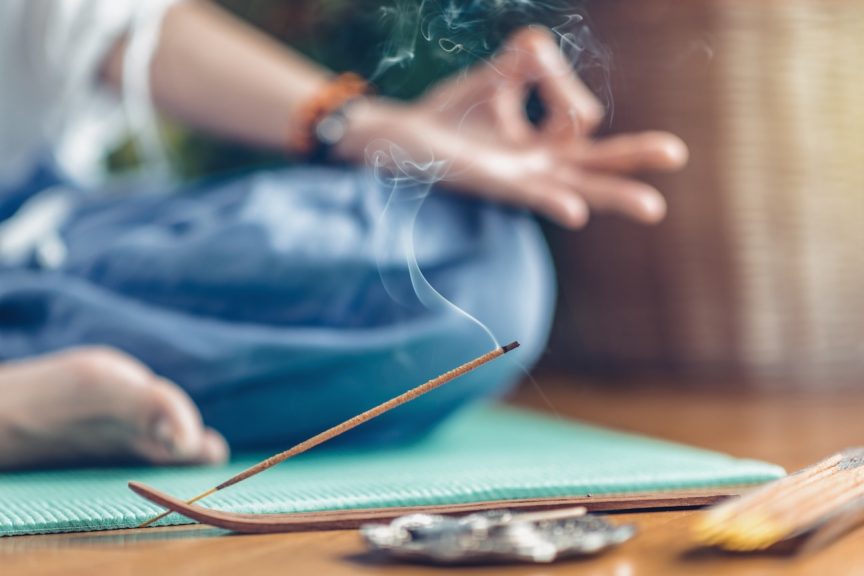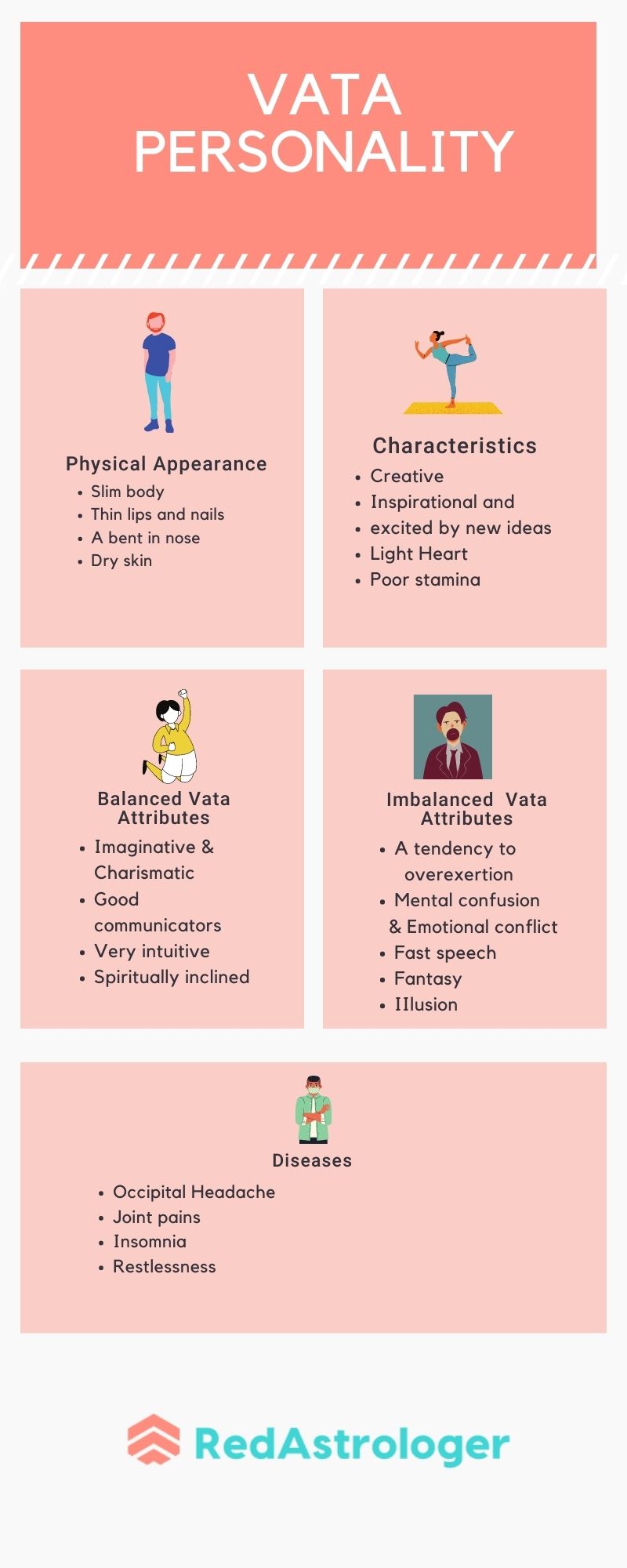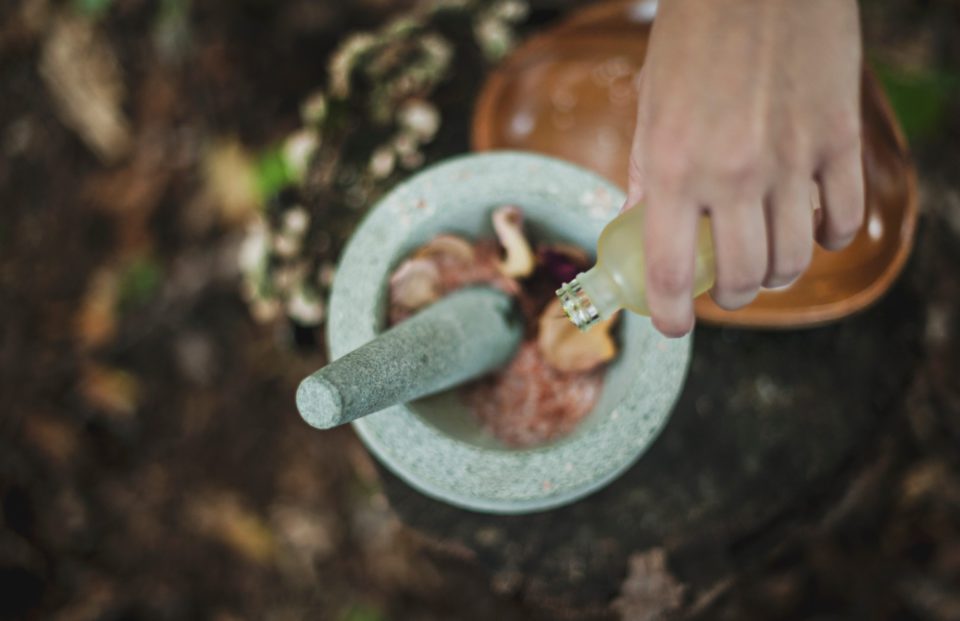Table of Contents
What is Vata Dosha?
What is Vata Dosha? The combination of Ether and Air form Vata. The normal functions of Vata in the body are movement, respiration, and ingestion of food and water.
Vata dosha is the Ayurvedic mind-body type that is associated with air and space. It’s light, cool, and dry in nature and it governs all movement in the mind and body, including blood flow, elimination of wastes, breathing, and the movement of thoughts across the mind.
Since Pitta and Kapha cannot move without it, Vata is considered the leader of the three Ayurvedic Principles in the body. It’s very important to keep Vata in good balance.
In this post I will discuss complete details on Vata Dosha, it’s subtypes, the balanced and imbalanced state. So first of all let’s check Are you Vata mind-body type?
People high in Vata tend to exhibit the following physical features also known as Vata body type:
Physical Characteristics of Vata Dosha
- Slender and don’t gain weight easily.
- Taller or shorter than average.
- “Thin” describes many bodily features (e.g hair, neck, fingers, lips).
- Energy fluctuates and often comes in bursts.
- Appetite is variable (i.e., high one day and low the next).
- Have a tendency to become bloated, gassy, or constipated.
- Skin frequently becomes dry. Tend to have cold hands and feet.
- Light sleepers and often have difficulty falling asleep.
- Prefer warm, moist weather to cold or dry weather.
Emotional Characteristics of Vata Dosha
- Creative and imaginative.
- Enjoy artistic forms of expression.
- The mind is active and often restless.
- Learn quickly but also forget quickly.
- Become “spaced out” quite easily.
- Have a tendency to feel anxious, nervous, and insecure.
- Speak quickly and use hand gestures.
- Always on the go.
- Lifestyle and daily routine are irregular.
- Dreams are active and colorful.
Consequently, now you must be sure that you have Vata mind-body type constitution. Momentarily let’s examine Is your Vata in balance?
Balanced Vata
| Mind | Body |
|---|---|
| Compassionate | Slender body frame, low weight |
| Mental Alertness | Good elimination of waste matter |
| Creative / Designer | Light sleep |
| Enthusiasim | A strong immune system |
| Good Communicator | Dry, brittle hair |
| Spiritually inclined | Fast pulse rate |
| Intuitive | Variable appetite |
Imbalanced Vata
| Mind | Body |
|---|---|
| Anxiety and worry | Physically over exerted and stressed out |
| Mental and emotional depression | Insomnia |
| A tendency of over exertion | Chronic tiredness, tics, tremors. |
| Mental confusion/ Emotional conflict | A weakened immune system |
| Impatient, Mood swings | Headaches (Occipital nerve) |
| Inability to make decisions | Cramps, spasms |
| Impulsiveness, Fear, worrying | low body weight |
| Fast and disconnected speech | Constipation, UTI (Urinary tract infection) |
| Lack of Confidence, Insecurity | Joint aches |
| Excess thinking, Illusions | Arthritis |
| Spacey and scattered feeling | Difficulty tolerating loud noise |
The Five Sub doshas of Vata
Vata governs all movement in the mind and body. Within Vata dosha, there are five distinct sub doshas that are responsible for moderating movement in various parts of the physiology.
They are as follows:
Prana Vata: Governs the senses, creative thinking, reasoning, and enthusiasm. When out of balance, Prana Vata can lead to worry, an overactive mind, sleep problems, and difficulty breathing.
Udana Vata: Governs the quality of voice, memory, and movements of thought. When out of balance, Udana Vata can lead to respiratory issues, throat and ear discomfort, and general fatigue.
Samana Vata: Governs the movement of food through the digestive tract. If Samana Vata moves out of balance, it can cause slow or rapid digestion, gas, intestinal cramps, poor assimilation, and weak tissues.
Apana Vata: Governs elimination of wastes, sexual function, and menstrual cycle. If out of balance, Apana Vata can lead to intestinal cramps, menstrual problems, lower back pain, irregularity, occasional diarrhea or constipation, and gas.
Vyana Vata: Governs blood flow, heart rhythm, perspiration, and sense of touch. When out of balance, Vyana Vata can cause dry or rough skin, nervousness, shakiness, poor blood flow, and stress-related problems.
Reasons Behind Imbalance Vata
- Consumption of food that aggravates the Vata.
- Too much anxiety and curiosity.
- Irregular daily routine.
- Consumption of alcohol or too much caffeine.
- Stress eating due to anxiety and depression
- Lack of physical activity.
- Loneliness and monotonous lifestyle.
- Continuous scrolling on social media apps increases anxiety and provokes Vata.
- Suppressing emotions and fears is also another reason behind imbalance.
How to Balance Vata with Diet
The major needs for Vata types are grounding foods and regularity. Therefore it is important for Vata to have regular meals at the same time every day and eat in a calm atmosphere.
| Prefer | Avoid | |
|---|---|---|
| Diet | Eat good quantity at regular intervals, and an adequate quantity of warm and oily foods. | Light dry, cold foods and drinks. |
| Grain | Wheat, rice, quinoa, yellow moong dal, green moong dal, and whole-grain bread | Chickpeas, kidney beans, black gram and soya beans. |
| Fruit | All ripe sweet and juicy fruits, pomegranate, mango, papaya, and oranges. | Unripe sour fruits, cranberries, and guava. |
| Vegetable | Zucchini, carrots, green peas, okra, parsley, and spinach | Raw vegetables and salads, cauliflower and cabbage. |
| Sweetener | Raw cane sugar, raw honey, and jaggery. | White and processed sugar. |
| Nuts | All nuts. and seeds, almonds, walnuts, and cashew, | Peanuts |
| Dairy | All dairy products like curd, cheese | Soya milk, powdered milk. |
| Non-vegetarian | Beef, chicken eggs and fish. | Lamb, rabbit, white meat of chicken. |
NOTE: Guidelines provided in this table are general. Specific adjustments for individual requirements may need to be made, e.g., food allergies, the strength of Agni, the season of the year, and degree of dosha predominance or aggravation.
Before making any changes to your diet, it is recommended that you check with your physician. This ayurvedic dietary guide is educational and is not intended to treat, cure, mitigate, or prevent any disease.
How to Balance Vata with Yoga
The natural tendency for Vata types is to focus on air and space qualities and love movement and flowing poses, such as Vinyasa Yoga. But what Vata needs the most is slow, grounding and calming practice, where you hold the poses and moving mindfully through sequences such as slow-paced sun salutation.

How to Balance Vata with Oil Massage

Benefits of Abhayanga for Vata Dosha
The peculiarities of Vata Dosha are cool, soft, smooth, and static. According to, Ayurveda like increases like, so you need to look for massage oils, including essential oils, which have warming, refreshing traits, such as black pepper, calamus, and rosemary.
The benefits you can expect to receive from a regular massage with any of these oils include:
- Moisturisation of dry skin.
- An increase in the suppleness and softness of the skin.
- More lustrous hair growth.
- An improvement in dryness of the scalp.
- Increased efficiency of the lymphatic drainage system.
- Invigoration of the circulatory system.
- Warmer extremities, fingers, nose, and toes.
- More energy throughout the day.
- Increased motivation to move about or engage in physical activities.
How to Balance Vata with Meditation

Calm your Mind with Meditation
Vata corresponds to Air and Space, therefore such people are constantly moving either physically or mentally. They are in habit of overthinking and overexerting their bodies. The practice of meditation brings many benefits both at the physical and mental levels.
And since Vata types are prone to be distracted by loud music, too many projects or technological devices going at a particular time. Meditation can help this monkey mind to sit at a place at a fixed time in a day. Now focus on breadth and just inhale and exhale for a few minutes, looking at the center of the forehead. Regularity in meditation can help Vata in calming their anxiety level and bring relaxation to their mind and soul.
Disclaimer
The sole purpose of these articles is to provide information about the tradition of Ayurveda. This information is not intended for use in the diagnosis, treatment, cure, or prevention of any disease.
If you have any serious acute or chronic health concerns, please consult a trained health professional who can fully assess your needs and address them effectively.
Did you find this post useful? Would you like to get back to it later? Save this pin below to your Pinterest Ayurveda Board.


